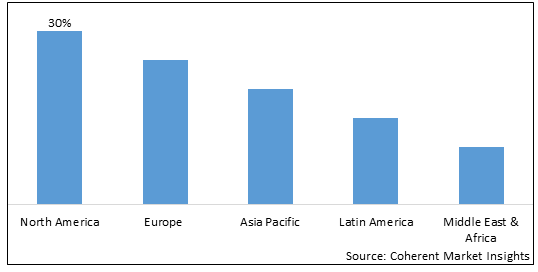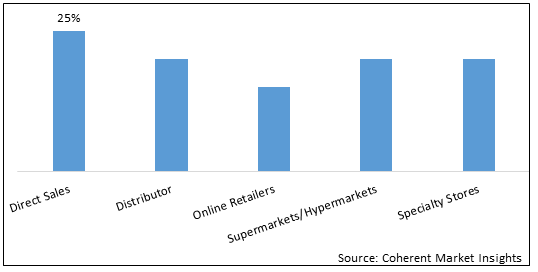Corn Grit Market is estimated to be valued at USD 1,001.1 Mn in 2025 and is expected to reach USD 1,475.7 Mn in 2032, exhibiting a compound annual growth rate (CAGR) of 5.7% from 2025 to 2032.
The growth of the global corn grit market is driven by the increasing demand for corn grit from the food and beverage industry. Corn grit is used in a variety of food products, such as grits, cornbread, tortillas, and snacks. Growing demand for gluten-free food products is also expected to boost the growth of the global corn grit market.
Increasing demand for corn grit from the animal feed industry is also expected to drive the market growth. Corn grit is a good source of energy and protein for animals. Rising disposable income of consumers in developing countries is also expected to boost the market growth.
Global Corn Grit Market Regional Insights
Figure 1. Global Corn Grit Market Share (%), By Region, 2025

To learn more about this report, Request sample copy
Global Corn Grit Market Drivers
Global Corn Grit Market Opportunities
Corn Grit Market Report Coverage
| Report Coverage | Details | ||
|---|---|---|---|
| Base Year: | 2024 | Market Size in 2025: | USD 1,001.1 Mn |
| Historical Data for: | 2020 To 2024 | Forecast Period: | 2025 To 2032 |
| Forecast Period 2025 to 2032 CAGR: | 5.7% | 2032 Value Projection: | USD 1,475.7 Mn |
| Geographies covered: |
|
||
| Segments covered: |
|
||
| Companies covered: |
Cargill Incorporated, Archer Daniels Midland Company (ADM), Bunge Limited, Ingredion Incorporated, Tate & Lyle PLC, Didion Milling, Semo Milling, Agrana Beteiligungs-AG, The Andersons, Inc., and LifeLine Foods |
||
| Growth Drivers: |
|
||
| Restraints & Challenges: |
|
||
Uncover macros and micros vetted on 75+ parameters: Get instant access to report
Global Corn Grit Market Trends
Global Corn Grit Market Restraints
Counterbalance: Awareness of the health benefits of corn grit needs to be made known to the common people. Also, corn grit manufacturers should focus on new product launches that are rich in vitamins, minerals, and proteins for the health-conscious populations
Analyst view of the Global Corn Grit Market:
Global corn grit market is expected to grow steadily driven by the increasing demand for convenience foods across regions. Corn grit is a popular breakfast food and finds wide application in baked goods due to its texture and binding properties. North America dominates the market which is aided by the large breakfast food industry in the US. Asia Pacific is likely to emerge as the fastest growing market with the rising health-conscious population fueling consumption of corn-based products in countries like India and China.
However, price volatility of corn may negatively impact the market players as corn is the primary raw material for producing grits. Unfavorable weather conditions can disrupt corn supply and lift prices. Substitutes like oats, wheat, and rice also provide competition. Nevertheless, corn grit manufacturers are focused on new product launches fortified with vitamins, minerals, and proteins to tap the health-conscious demographic. The launch of gluten-free and organic variants is also expanding the consumer base.
Online retail is expected to offer lucrative growth opportunities for corn grit suppliers. E-commerce giants are boosting the product discovery rate. Leading brands are engaged in promotional activities on digital channels and partnering with online food retailers to boost market growth. The market is consolidated with key market players from North America which have a strong base. Local players in emerging economies may look at regional expansion opportunities through tie-ups with local food processing companies.
Recent Developments
New product launches
Acquisition and partnerships
Figure 2. Global Corn Grit Market Share (%), By Distribution Channel, 2025

To learn more about this report, Request sample copy
Top Companies in Global Corn Grit Market
Definition: The term "corn grit market" refers to the industry segment that focuses on the production, distribution, and sale of corn grits, which are coarse ground corn or maize particles created through the milling process. Corn grits are a versatile food ingredient used in various
Share
Share
About Author
Yash Doshi is a Senior Management Consultant. He has 12+ years of experience in conducting research and handling consulting projects across verticals in APAC, EMEA, and the Americas.
He brings strong acumen in helping chemical companies navigate complex challenges and identify growth opportunities. He has deep expertise across the chemicals value chain, including commodity, specialty and fine chemicals, plastics and polymers, and petrochemicals. Yash is a sought-after speaker at industry conferences and contributes to various publications on topics related commodity, specialty and fine chemicals, plastics and polymers, and petrochemicals.
Missing comfort of reading report in your local language? Find your preferred language :
Transform your Strategy with Exclusive Trending Reports :
Frequently Asked Questions
Select a License Type
Credibility and Certifications

860519526

9001:2015
27001:2022


Joining thousands of companies around the world committed to making the Excellent Business Solutions.
View All Our Clients
US Reciprocal Tax Impact Analysis On Corn Grit Market
Stay updated on tariff changes with expert insights and timely information